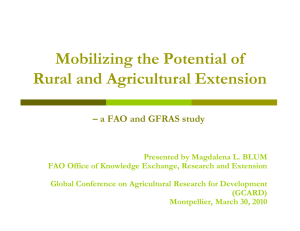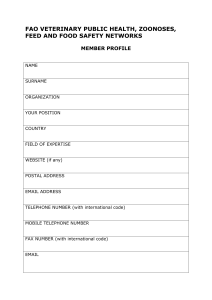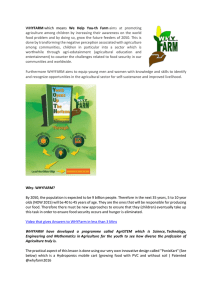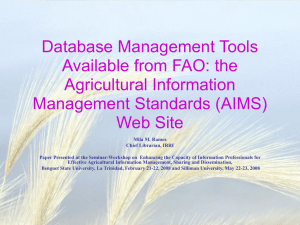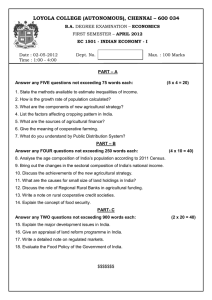INVESTMENT IN AGRICULTURE THE CHALLENGES
advertisement
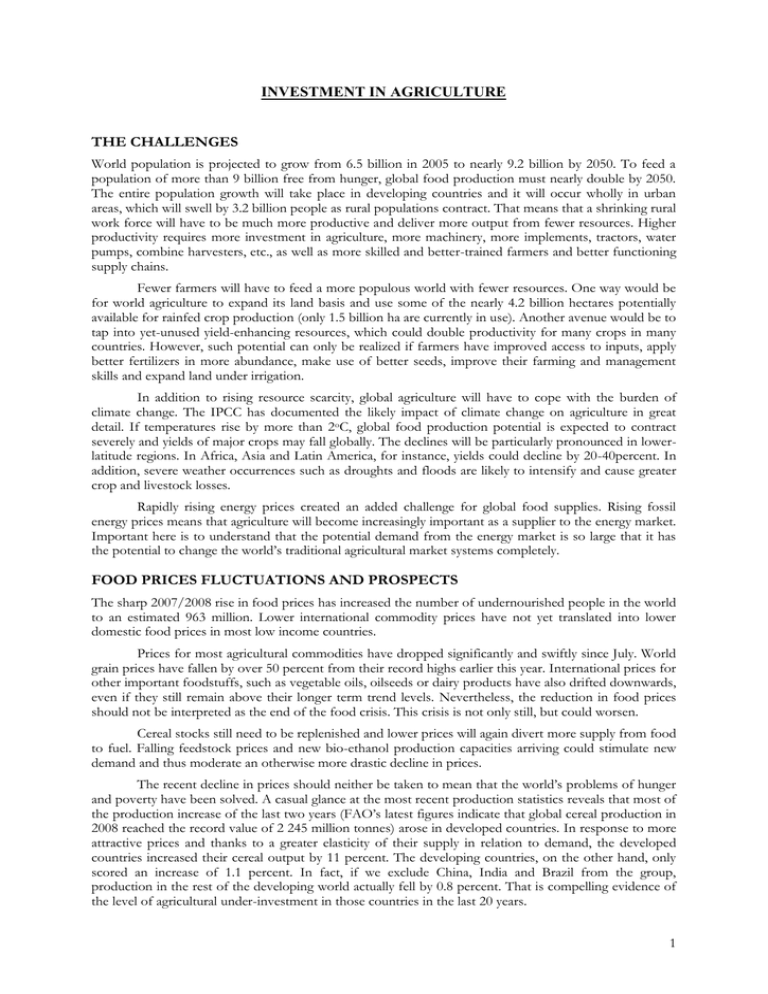
INVESTMENT IN AGRICULTURE THE CHALLENGES World population is projected to grow from 6.5 billion in 2005 to nearly 9.2 billion by 2050. To feed a population of more than 9 billion free from hunger, global food production must nearly double by 2050. The entire population growth will take place in developing countries and it will occur wholly in urban areas, which will swell by 3.2 billion people as rural populations contract. That means that a shrinking rural work force will have to be much more productive and deliver more output from fewer resources. Higher productivity requires more investment in agriculture, more machinery, more implements, tractors, water pumps, combine harvesters, etc., as well as more skilled and better-trained farmers and better functioning supply chains. Fewer farmers will have to feed a more populous world with fewer resources. One way would be for world agriculture to expand its land basis and use some of the nearly 4.2 billion hectares potentially available for rainfed crop production (only 1.5 billion ha are currently in use). Another avenue would be to tap into yet-unused yield-enhancing resources, which could double productivity for many crops in many countries. However, such potential can only be realized if farmers have improved access to inputs, apply better fertilizers in more abundance, make use of better seeds, improve their farming and management skills and expand land under irrigation. In addition to rising resource scarcity, global agriculture will have to cope with the burden of climate change. The IPCC has documented the likely impact of climate change on agriculture in great detail. If temperatures rise by more than 2oC, global food production potential is expected to contract severely and yields of major crops may fall globally. The declines will be particularly pronounced in lowerlatitude regions. In Africa, Asia and Latin America, for instance, yields could decline by 20-40percent. In addition, severe weather occurrences such as droughts and floods are likely to intensify and cause greater crop and livestock losses. Rapidly rising energy prices created an added challenge for global food supplies. Rising fossil energy prices means that agriculture will become increasingly important as a supplier to the energy market. Important here is to understand that the potential demand from the energy market is so large that it has the potential to change the world’s traditional agricultural market systems completely. FOOD PRICES FLUCTUATIONS AND PROSPECTS The sharp 2007/2008 rise in food prices has increased the number of undernourished people in the world to an estimated 963 million. Lower international commodity prices have not yet translated into lower domestic food prices in most low income countries. Prices for most agricultural commodities have dropped significantly and swiftly since July. World grain prices have fallen by over 50 percent from their record highs earlier this year. International prices for other important foodstuffs, such as vegetable oils, oilseeds or dairy products have also drifted downwards, even if they still remain above their longer term trend levels. Nevertheless, the reduction in food prices should not be interpreted as the end of the food crisis. This crisis is not only still, but could worsen. Cereal stocks still need to be replenished and lower prices will again divert more supply from food to fuel. Falling feedstock prices and new bio-ethanol production capacities arriving could stimulate new demand and thus moderate an otherwise more drastic decline in prices. The recent decline in prices should neither be taken to mean that the world’s problems of hunger and poverty have been solved. A casual glance at the most recent production statistics reveals that most of the production increase of the last two years (FAO’s latest figures indicate that global cereal production in 2008 reached the record value of 2 245 million tonnes) arose in developed countries. In response to more attractive prices and thanks to a greater elasticity of their supply in relation to demand, the developed countries increased their cereal output by 11 percent. The developing countries, on the other hand, only scored an increase of 1.1 percent. In fact, if we exclude China, India and Brazil from the group, production in the rest of the developing world actually fell by 0.8 percent. That is compelling evidence of the level of agricultural under-investment in those countries in the last 20 years. 1 The benefits of higher prices have not accrued to producers in many developing countries, for their supply response was small in 2007 and virtually zero in 2008. The reasons are manifold. Higher prices of key agricultural inputs such as fertilizers, seeds and energy, made it more difficult for all farmers to step up production. But particularly hard hit were poor subsistence producers who have been confronted with higher input prices without producing a marketable surplus that would earn them higher revenues. Dropping prices and economic uncertainty could discourage some farmers from investing in means of production. There could be less planting next season, leading to a significant fall in output in 2009/10 and a steeper price surge than in 2007/08 if it is not tempered by the impact of economic recession on incomes. Even more worrisome is the notion that prices are being driven downwards by slowing demand. This is being evidenced by the fact that almost all commodity prices are declining in unison alongside a deteriorating global economic outlook. The entrenchment of the global financial crisis could mean that the economic slump may even be faster and more severe than currently anticipated. To the extent prices do reflect an anticipated slow-down in economic growth that constricts demand; lower prices may even be associated with more poverty and hunger rather than less. FINANCIAL CRISIS AND AGRICULTURE The current financial crisis will affect agricultural sector in many countries negatively, including those in the developing world. This year’s record cereal harvest and the recent fall in food prices should, therefore, not create a false sense of security. For example, if the current price volatility and liquidity conditions prevail in 2008/09, plantings and output could be affected to such an extent that a new price surge might take place in 2009/10, unleashing even more severe food crises than those experienced recently. The financial crisis of the last few months has amplified downward price movements, contributed to tighten credit markets, and introduced larger uncertainty about next year’s prospects, so that many producers are adopting very conservative planting decisions. The impact of the financial crisis will be felt in developing countries at the macro-level, with potentially negative effects on their agriculture sector and on their food security. The channels through which agricultural markets will be affected are on both the demand and supply sides. Demand side: the slowing down of economic growth would affect international demand for commodities, especially raw materials and livestock products, negatively, with such impact likely to be more limited for staples such as rice. The prevailing uncertainty and consequent negative market expectations could further dampen demand. In general, lower food prices are good news for consumers, but suppress incentives for producers to make the investments necessary and 2 desirable to secure greater food security in the medium term. In addition, the drop of food prices benefiting consumers would probably not be sufficiently to compensate them for declining household incomes in the event of a worldwide recession, as economic activity slows, employment falls and remittances from abroad dry up. Supply side: the reduction of price incentives is likely to result in some cutback in agricultural production. The financial crisis may also depress input prices, especially if energy prices continue to weaken, as this could also trigger a reduction in fertiliser and all energy-related costs. The net effect on production will depend upon the relative speed of adjustment of output and input prices. However, even more critical is likely to be the impact of the financial crisis on the availability of credit, which is widely recognized as one of the major constraints to agriculture development in the developing countries. The combination of falling agricultural prices and reduced access to credit may have a knock off impact on agricultural production, with very serious implications for the global food security. There is a real risk that as a consequence of the current world economic problems people will have to reduce their food intake and the number of hungry could rise further. In this regard, it will be particularly important that donor countries and investors meet their commitments taken towards the development of agriculture in the developing countries, especially at a time when agriculture may act as a “buffer” and help cushion greater losses incurred in other sectors of the economy. CENTRAL ROLE OF INVESTMENT IN AGRICULTURE Agriculture and the rural sectors remain vital to pursuing the related goals of food security, growth, poverty alleviation and sustainable development. Agriculture provides the primary source of livelihood for 36 percent of the world’s total workforce. In the heavily populated countries of Asia and the Pacific, this share ranges from 40 to 50 percent, and in sub-Saharan Africa, two-thirds of the working population still make their living from agriculture (ILO, 20071). Agriculture is a key to poverty reduction. Strong agricultural growth has been a consistent feature of countries that have successfully managed to reduce poverty. GDP growth generated in agriculture is, on average, four times more effective in benefiting the poorest half of the population than growth generated outside agriculture, although this effect declines as countries get richer.2 Increased farm production improves farmers’ incomes, generates on-farm employment and lowers food prices, all of which reduce poverty as the poor typically spend 60 - 70 percent of their income on food. Recent studies suggest that an even more significant effect on rural poverty derives from increased farm incomes stimulating demand for the goods and services offered by the small - scale enterprise sector. Where labour is abundant, agricultural growth generates significant income and employment multipliers within the local non - farm economy. Continued agricultural growth, and hence more water for irrigation, is essential if this sub-sector is to play its role in reducing poverty.3 Such increases in productivity will require increased investment in agriculture, and especially in land and water development. However, investment in these areas is decreasing or at best stagnating. Governments, authorities and development practitioners are thus facing the paradox of having agreed to development goals requiring increased production with diminishing per capita resources, but without the concomitant investment to do this THE DECLINE OF INVESTMENT IN AGRICULTURE The dramatic situation demonstrated above is the result of the low priority given to agriculture. The facts speak for themselves: public aid to agriculture fell from US$8 billion (2004 equivalent) in 1984 to US$3.4 1 ILO. 2007. Chapter 4. Employment by sector. In Key indicators of the labour market (KILM), 5th edition. Available at: www.ilo.org/public/english/employment/strat/kilm/download/kilm04.pdf 2 World Bank (2007), World Development Report 2008 3 Mellor, J.W. 2000. Agricultural growth, rural employment and poverty reduction: non - tradables, public expenditure and balanced growth. Paper prepared for the World Bank Rural Week 2000, Poverty or prosperity: rural people in a globalized economy.\ IFAD. 2001. Rural poverty report 2001: the challenge of ending rural poverty. Rome, International Fund for Agricultural Development 3 billion in 2004, which represents a reduction in real terms of 58 percent. The share of agriculture in Official Development Assistance fell from 17 percent in 1980 to 3 percent in 2006. The international and regional finance institutions have posted a sharp decline in resources for an activity that is the main livelihood for 70 percent of the world’s poor. In one noteworthy case, the loan portfolio of an institution to agriculture dropped from 33 percent in 1979 to 1 percent in 2007. In many African countries, spending on agriculture relative to GDP is well below the target set by the 2003 Maputo Declaration of Heads of State and Government of the African Union, which established that 10 percent of budgetary allocations should go to agriculture and rural development by 2008. Only in Asia has spending increased relative to GDP over the 1980-2002 period, as the result of a near tripling in real terms. The relative decline is most dramatic in Latin America, the only region where expenditures declined in absolute terms, although there has been a recovery between 1990 and 2002. A number of studies show positive growth and poverty reduction effects from public spending in agriculture and rural development. At the same time, many low-income countries depend on external assistance for agriculture. Yet, external commitments in real terms have steadily declined since the 1980s and multilateral assistance has declined proportionately much more than bilateral assistance. THE INVESTMENT ROAD MAP The challenges that the world is currently facing can only be mastered if both private and public hands start investing in agriculture now. The FAO has tabled an investment road map to 2015 and gauged its potential benefits. This assessment suggests that a total annual investment volume of US$ 30 billion in the following five areas would engender an overall annual benefit of US$ 120 billion. 1. Improve agricultural productivity and enhance livelihoods and food security in poor rural communities. 2. Develop and conserve natural resources. 3. Expand and improve rural infrastructure and broaden market access. 4. Strengthen capacity for knowledge generation and dissemination. 5. Ensure access to food for the most-needy through safety nets and other direct assistance. 4 INVESTING IN WATER DEVELOPMENT The Importance of Investing in Water for Agriculture By 2025, two-thirds of the world population could be under “stress conditions” (500-1000 m³/year/capita), and 1800 million people are expected to be living in countries or regions with “absolute water scarcity” (<500 m³/year/capita). Water security is essential for growth and poverty reduction. The water sector provides wide benefits across other sectors and is one sector that has important linkages to the attainment of all the other MDG goals. It is estimated that at any given time, about half of the population in developing countries are sick with one water-related disease or the other. Productivity is directly impacted and enormous pressure is placed on the health infrastructure, not to mention the huge economic costs incurred. An adequate water management in agriculture is also unanimously considered as a key to development. Irrigation increases cropping intensity and contributes to expansion in cropped areas. It increases yields, stabilizes output, enables crop diversification, reduces risk and increases farm incomes and employment. Through its influence on agricultural incomes, irrigation has a multiplier effect on non-farm incomes and it crucially contributes to food security and poverty alleviation. In India, the multiplier effect of higher incomes in agriculture creating off-farm employment opportunities helped decrease the number of people below the poverty line from 50 percent to approximately 35 percent between the mid - 1970s and 1990. 4 Irrigation has good distributional effects as most irrigation projects have targeted private farmers (mostly smallholders) and its benefits accrue mainly in rural areas. Two - thirds of the income of the rural poor comes from farming and most of the rest depends for growth on linkages to farming. By improving agricultural productivity, irrigation contributes significantly to overall growth and development. Water also provides a range of productive opportunities, so investments in water for agriculture, hydropower and industry, for example, can be seen as drivers of growth. FAO estimates that water for agriculture needs to increase 60% to feed an additional 2 billion people by 2030, even as urban water requirements are increasing. The Investments in Water Since the beginning of the 90’s, despite strong political commitments made by donor countries for the water sector, the amounts of ODA for water have risen only slightly from US$2.8 billion in 1992 to US$3.8 billion in 2002. After a worrying decrease in commitments between 1999 and 2002, it seems that the downward trend was reversed as a large rise in commitments could be observed in the year 2004, with annual ODA amount reaching US$4.8 billion. But the large increase observed in 2004 is largely due to the important amounts of ODA for water provided to Iraq. The figure below also illustrates the large variability of ODA for water from one year to another, which leads to the unpredictability of aid flows in the water sector. Nearly half of the ODA committed to the water sector in 2003-2004 benefited to large water supply and sanitation systems. Water resources policy/administrative management accounted for another quarter, and basic drinking water supply and basic sanitation received 20%. Waste management or water resources protection, only received small amounts. According to the 2006 Human Development Report, this predominance of large-scale water and sanitation infrastructure indicates a strong urban focus of aid flows to the water sector. Datt, G. 1998. Poverty in India and Indian states: an update. FCND Discussion Paper No. 47. Washington, DC, International Food Policy Research Institute 4 5 ODA commitments for water in 2004 constant dollars between 1992 and 2004: annual commitments (bars) and five-year moving average (curve) A clear downward trend in investment in water for agriculture can be seen at global level: donor spending on irrigation reached a peak of more than $1 billion a year (in 1980 US dollars) in the late 1970s and early 1980s and then fell to less than half that level by the late 1980s (Rosegrant and Svendsen 1993). Even though lending for irrigation and drainage partially recovered in the late 1990s, lending for 2002-05 was still less than half the level for 1978-81, very low compared with lending in other regions. Also, investment in agricultural water in Sub-Saharan Africa has been only a small proportion of the total for the water sector-just 14 percent of African Development Bank lending to the water sector as a whole during 1968-2001. As it is shown in the figure below, ODA for water is not targeting enough the Least Developed Countries (LDCs). In 2003-2004 the proportion of ODA for water that benefited to the LDCs decreased in comparison with 2001-2002. ODA for water (DAC definition) by income group, commitments 1999-2004 6 Investment Needs in Water for Agriculture The WWC/GWP Vision and Framework for Action in 2000, estimated that the annual investment requirements for agricultural water would need to rise from the current levels, variously estimated to be in the range US$25-30 billion, to US$40 billion by 2025. In a recent systematic analysis of the options for meeting the MDG for Hunger, the annual investment and running cost of all water resource related management was estimated to be US$ 47 billion in the period 2005-2015, rising to US$67 billion in 2015-2030, and falling back to US$58 billion in 20302050. Future investment in agricultural water management is likely to be very different from the historic pattern. Much future investment is likely to be in the modernization and rehabilitation of existing assets and investment in new hydraulic infrastructure, such as dams, is likely to be more selective than previously. It is not just the amount of finance that is of concern: the timing of cash flow and its scheduling are also crucial. Many large schemes, especially in Asia, require upgrading to be financed on a continuous basis, over and above what is recovered for O&M. The Ministerial Conference on “Water for Agriculture and Energy in Africa: the Challenges of Climate Change” organized by FAO and other partner organizations and held in Sirte, Libya, in December 2008 provided an opportunity to analyse the current situation and future needs for investment in water for agriculture and energy in the continent. The conference addressed the financial aspects, both in terms of costs and sources of funding requirements. Its work served to draw up a detailed portfolio of about 1000 projects and programmes of investment in water control for agriculture and energy in the 53 African countries, with a total budget of 65 billion US dollars spread over twenty years. 53 National Investment Briefs representing all African countries have been prepared and a short-, medium- and long-term assessment has been made so thoroughly and so precisely, considering investment in water control at the level of villages, extensive irrigation systems and major river basins, both for agriculture and for hydroelectric power. FAO calls upon countries to focus on a much more strategic development of the available land and water resources to service effective demand for food products and agricultural commodities. Countries should create irrigation systems that are more flexible and service oriented, and water institutions that are more transparent and accountable. Low cost, small-scale options in water harvesting, irrigation and drainage also have to be emphasised. For instance, water harvesting – collecting water in structures ranging from small furrows to dams – allows farmers to conserve rainwater and direct it to crops. And localised methods such as drip irrigation, which direct water only where it is needed, are more efficient than flooding fields and using sprinklers. THE COMMITMENTS The High-Level Conference on World Food Security, which was held in Rome from 3 to 5 June 2008, clearly stated that investment in agricultural production was the basis for any sustainable solution to the global food crisis and that adequate resources were needed. Although this was not a pledging conference, some US$11 billion were promised at the time. If we add this sum to other announcements made before and after the conference, the total pledges reach US$22 billion. This is clearly a very encouraging figure, but these are only promises that still need to be fulfilled. In the framework of the commitments made at the FAO High-Level Conference on World Food Security and the G-8 Summit in July in Japan, US$30 billion should be invested each year in agriculture (equivalent to 8 percent of the subsidies of OECD countries to their farmers and to 2.5 percent of world military spending) in order to combat hunger and to feed a growing population. This way, it will be possible to ensure world food security and to enable agriculture to become the engine of sustainable economic growth in the developing countries. On a regional scale, in Maputo, in 2003, the Heads of State and Governments of the African Union committed to allocating at least 10 percent of their national budgetary resources for agriculture and 7 rural development. Unfortunately, progress remains too slow. Estimates indicate that about a dozen countries have reached or exceeded half of the Maputo budget target, but only a handful have achieved it. Although there are encouraging signs, such as the European Union’s approval of the ‘Food Facility for Developing Countries’ amounting to 1 billion euros, the replenishment of IFAD’s resources and greater credit to the agricultural sector from the World Bank, the financial resources for intervention still fall far short of the level required: investments in agriculture are decreasing or at best stagnating and governments, authorities and development practitioners are thus facing the paradox of having agreed to development goals requiring increased agricultural production with diminishing per capita resources, but without the concomitant investment to do this. The world is now in serious financial and economic crisis. This is added to the food crisis that has shaken the international agricultural economy and has highlighted the fragility of world food security. In a context of global instability, greater uncertainty in the financial system, non predictable price fluctuations investments in agriculture appear to be the cornerstone of any sustainable solution to overcome the challenge not only to ensure adequate food for 963 million hungry people in the world, but also to feed 9.2 billion people in 2050. That will mean doubling world food production with the financial resources needed for investment in agriculture. CLIMATE CHANGE IMPACTS ON AGRICULTURE Agriculture is sensitive to climate. Its production processes are therefore likely to be affected by climate change. In general, impacts are expected to be positive in temperate regions and negative in tropical ones, but there is still uncertainly about how projected changes will play out at the local level, and potential impacts may be altered by the adoption of risk management measures and adaptation strategies that strengthen preparedness and resilience. The food security implications of changes in agricultural production patterns and performance are of two kinds: Impacts on the production of food will affect food supply at the global and local levels. Globally, higher yields in temperate regions could offset lower yields in tropical regions. However, in many low-income countries with limited financial capacity to trade and high dependence on their own production to cover food requirements, it may not be possible to offset declines in local supply without increasing reliance on food aid. Impacts on all forms of agricultural production will affect livelihoods and access to food. Producer groups that are less able to deal with climate change, such as the rural poor in developing countries, risk having their safety and welfare compromised. Warming of more than 2 ºC is expected to have negative affects on production in all regions (IPCC, 20075). The supply of meat and other livestock products will be influenced by crop production trends, as feed crops account for roughly 25 percent of the world’s cropland. Constraints on water availability are a growing concern, which climate change will exacerbate. Increased intensity and frequency of storms, altered hydrological cycles, and precipitation variance also have long-term implications on the viability of current world agro-ecosystems and future food availability. The potential impacts on rainfed agriculture vis-à-vis irrigated systems are still not well understood: prolonged and repeated droughts can cause loss of productive assets, which undermines the sustainability of livelihood systems based on rainfed agriculture. The developing world already contends with chronic food problems. Climate change presents yet another significant challenge to be met. The estimate for Africa is that 25–42 percent of species habitats could be lost, affecting both food and non-food crops. In developing countries, 11 percent of arable land could be affected by climate change, including a reduction of cereal production in up to 65 countries, about 16 percent of agricultural GDP (FAO Committee on Food Security, Report of 31st Session, 2005). IPCC. 2007. Climate Change 2007 _ the physical science basis. Contribution of Working Group I to the Fourth Assessment Report of IPCC. Cambridge. UK. Cambridge University Press 5 8 The table below shows the possible direction of changes from negative to positive for most regions when assuming adaptation. For Europe, the Former Soviet Union and Centrally Planned China, impacts could be mostly positive. Concerning the adaptation scenario, it is often assumed that farmers have limited capacities to adapt to changing circumstances”. Perfect adaptation is less realistic as imperfect information, limited access to technology and institutional weaknesses reduce the extent and effectiveness of adaptation. 6 The general findings from the impacts on yields and production are mirrored in the results of the economic analysis: 1. Globally aggregated impacts are small (-1.5% – +2.6%) in terms of changes in GDP from agriculture. 2. The agricultural GDP in developed countries would likely benefit from climate change. 3. With the exception of Latin America, developing countries would face a decrease of GDP from agriculture due to climate change. Asia (-4% for high emission scenarios) and Africa (-2 – -9% for 3 of the 4 GCMs) would generally be negatively affected. 4. North America could gain in all scenarios, as could the former Soviet Union, from climateinduced changes in production conditions. Western Europe though, would lose in all scenarios. Tol, R.S.J. (2002). New estimates of the damage Costs of Climate Change, Part I: Benchmark Estimates. Environmental and Resource Economics, 21 (1), 47-73 6 9 TARIFFS AND TRADE OECD countries are still dominant players in world agricultural trade across categories, and particularly for processed products, the production of which relies on the availability of specialized skills. There are, however, some noticeable structural changes. Exports of processed products by middle-income countries grew at double-digit rates between 1985 and 2004. Those countries also saw rapid growth in their horticultural exports, though the OECD countries still dominate. The agricultural exports of developing countries still face significant tariff barriers and tariff escalation in developed country markets, although LDCs benefit from substantial preferences Tariff escalation is only one factor limiting the capture of value added by developing countries. Another is the high market concentration on the buyers’ side of agricultural commodity markets and the high fragmentation on the developing country producers’ side. Supporting product differentiation through branding and other value-adding activities, on the one hand, and strengthening extension services for smaller producers, on the other, have been tried with success in some countries as a way to overcome these challenges. The export taxes and restrictions had a detrimental effect on the response of the developing countries to the high international prices that were not always and not fully transmitted to domestic markets, burdening even commercial farmers with higher costs and stagnant output prices. The policy response to soaring food prices in developing countries was indeed wide-ranging. An FAO survey found that nearly 40 countries reduced grain import tariffs and more than 20 countries imposed export controls of some kind – either in the form of taxes or quantitative controls such as outright bans and quotas. Moreover, governments and donors should avoid reducing aid to developing countries’ agriculture and introducing protectionist trade measures in response to the unfolding global financial crisis. In a statement marking the 34th Session of FAO’s Committee on World Food Security (CFS) from October 14-17, Diouf warned that such steps could increase the risk of another food crisis occurring next year. 10 CONCLUSION: FAO PROMOTING INVESTMENT Food production must double by 2050 if we are to feed a world population expected to reach 9.2 billion people at that date. Almost whole of this population increase will take place in the developing countries. Moreover, by 2050, the urban population will grow by about 3.2 billion people, while the rural population will fall by some 500 million people. We will therefore have to raise agricultural productivity in the developing countries by investing in rural infrastructure (water management, rural roads, storage facilities, slaughterhouses etc.) but also by using modern factors of production. The Special Programme for Food Security (SPFS), launched in 1996 and now operational in more than 70 countries focuses on the Low-Income Food-Deficit Countries (LIFDCs)-countries least able to meet their food needs with imports with the main objective is to help LIFDCs to improve food security at the national and household levels, through rapid increases in food production and productivity, by reducing year-to-year variability in production on an economically and environmentally sustainable basis and by improving people’s access to food. On 17 December 2007, the Director General of FAO launched an initiative to combat soaring food prices and invited bilateral and multilateral donors to allocate 1.7 billion US dollars to developing countries to enable their resource-poor farmers to obtain seeds, fertilizers, animal feed and other inputs. FAO's initial financing of this initiative in 79 countries should act as a catalyst and spur donors and national governments to support small-farmer access to inputs, on a broader scale. In this connection, I is worth to point out that, in the last 10 years, FAO has implemented 1 022 projects dealing with the distribution of agricultural inputs with a budget of about 931 million US dollars. At the global level, the High-Level Task Force on the Global Food Security Crisis, set up last April by the UN Secretary-General, under his chairmanship, and the Vice-Chairmanship of the DirectorGeneral of FAO, has drawn up a global plan of action: the "Comprehensive Framework for Action". In addition, the Heads of State and Government of the G8 countries, in the final communiqué of their Summit last July, recommended the establishment of a Global Partnership on Agriculture and Food, involving all actors concerned: public and private sectors, international institutions, civil society and farmers’ organizations. They have also proposed the set up of a global network of high-level experts on food and agriculture. The world is now in serious financial and economic crisis. This is added to the food crisis that has shaken the international agricultural economy and has highlighted the fragility of world food security. In a 11 context of global instability, greater uncertainty in the financial system, non predictable price fluctuations investments in agriculture appear to be the cornerstone of any sustainable solution to overcome the challenge not only to ensure adequate food for 963 million hungry people in the world, but also to feed 9.2 billion people in 2050. That will mean doubling world food production with the financial resources needed for investment in agriculture. REFERENCES William R. Cline, 2007. Global Warming and Agriculture - Impact Estimates by Country. 250 pp. ISBN 978-0-88132-403-7 FAO, 2007. Adaptation to climate change in agriculture, forestry and fisheries: Perspective, framework and priorities. FAO: Rome FAO, 2008. Climate Change and Food Security: a Framework Document. FAO: Rome. FAO, 2008. Committee on World Food Security. Thirty-fourth Session. Assessment of the world food security and nutrition situation Rome, 14-17 October 2008 FAO, 2009. Allocution de M. Jacques Diouf, Directeur Général de l'Organisation des Nations Unies pour l'alimentation et l'agriculture (FAO). World Water Forum 5. L’eau pour l’alimentation et l’élimination de la pauvreté. Table ronde Ministérielle. Istanbul, 21 Mars 2009. VERSION PROVISOIRE 25/2/2009 FAO, 2008. Statement of the Director-General. Thirty-fifth Special Session. Rome, 18-22 November 2008 FAO, 2009. Address by Jacques Diouf, Director-General of the Food and Agriculture Organization of the United Nations (FAO). High-Level Meeting on “Food Security for All”, Madrid, 26-27 January 2009 FAO, 2009. Food prices indices data World Water Forum, 2006 .Financing Water for Agriculture. PROGRESS REPORT No 1 Contribution to the Task Force on Financing Water chaired by Angel Gurria and submitted to the 4th World Water Forum, Mexico, March 2006 Shenggen Fan and Mark W. Rosegrant, 2008. Investing in Agriculture to Overcome the World Food Crisis and Reduce Poverty and Hunger. IFPRI Policy Brief 3, June 2008 Kenji Yoshinaga., Director, Land and Water Development Division, FAO, 2002. The benefits of investment in land and water. FAO: Rome FAO website, 2009. Falling prices in perspective: http://www.fao.org/docrep/011/ai474e/ai474e13.htm FAO, 2008. Address of the Director-General Islamic Development Bank. Washington, D.C., 12 October 2008: http://www.fao.org/english/dg/2008/12october08.html AfDB, 2009. Achieving Outcomes in African Development through Water: http://www.afdb.org/en/topics-sectors/sectors/water-supply-sanitation/bank-group-vision/ UNESCO, 2004 : http://wwap.unesco.org/ev.php?URL_ID=6480&URL_DO=DO_TOPIC&URL_SECTION= 201&PHPSESSID=bc12e5d7e7f78af5 Millennium Project, 2007. Global Challenges Facing Humanity: http://www.millennium-project.org/millennium/Global_Challenges/chall-03.html 12
